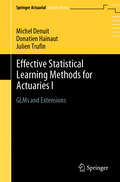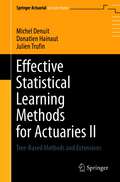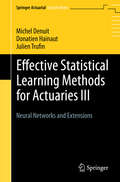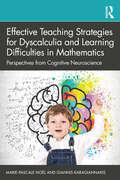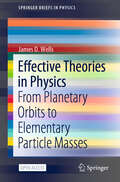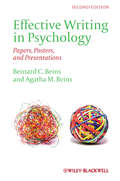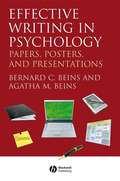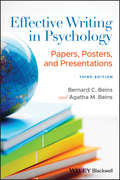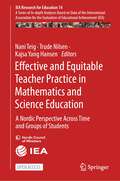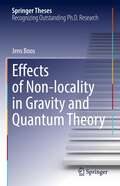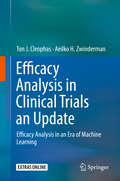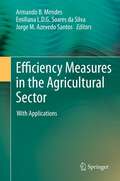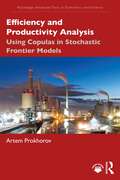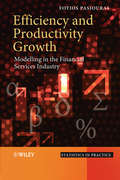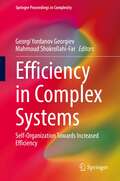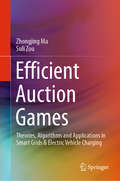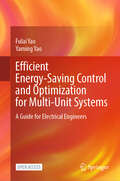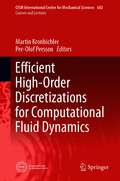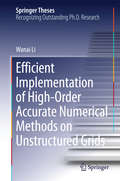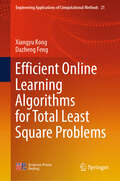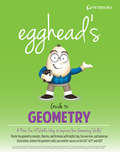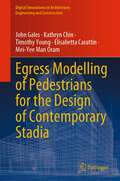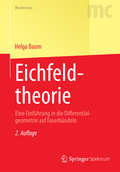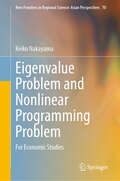- Table View
- List View
Effective Statistical Learning Methods for Actuaries I: GLMs and Extensions (Springer Actuarial)
by Michel Denuit Donatien Hainaut Julien TrufinThis book summarizes the state of the art in generalized linear models (GLMs) and their various extensions: GAMs, mixed models and credibility, and some nonlinear variants (GNMs). In order to deal with tail events, analytical tools from Extreme Value Theory are presented. Going beyond mean modeling, it considers volatility modeling (double GLMs) and the general modeling of location, scale and shape parameters (GAMLSS). Actuaries need these advanced analytical tools to turn the massive data sets now at their disposal into opportunities. The exposition alternates between methodological aspects and case studies, providing numerical illustrations using the R statistical software. The technical prerequisites are kept at a reasonable level in order to reach a broad readership. This is the first of three volumes entitled Effective Statistical Learning Methods for Actuaries. Written by actuaries for actuaries, this series offers a comprehensive overview of insurance data analytics with applications to P&C, life and health insurance. Although closely related to the other two volumes, this volume can be read independently.
Effective Statistical Learning Methods for Actuaries II: Tree-Based Methods and Extensions (Springer Actuarial)
by Michel Denuit Donatien Hainaut Julien TrufinThis book summarizes the state of the art in tree-based methods for insurance: regression trees, random forests and boosting methods. It also exhibits the tools which make it possible to assess the predictive performance of tree-based models. Actuaries need these advanced analytical tools to turn the massive data sets now at their disposal into opportunities. The exposition alternates between methodological aspects and numerical illustrations or case studies. All numerical illustrations are performed with the R statistical software. The technical prerequisites are kept at a reasonable level in order to reach a broad readership. In particular, master's students in actuarial sciences and actuaries wishing to update their skills in machine learning will find the book useful. This is the second of three volumes entitled Effective Statistical Learning Methods for Actuaries. Written by actuaries for actuaries, this series offers a comprehensive overview of insurance data analytics with applications to P&C, life and health insurance.
Effective Statistical Learning Methods for Actuaries III: Neural Networks and Extensions (Springer Actuarial)
by Michel Denuit Donatien Hainaut Julien TrufinThis book reviews some of the most recent developments in neural networks, with a focus on applications in actuarial sciences and finance. It simultaneously introduces the relevant tools for developing and analyzing neural networks, in a style that is mathematically rigorous yet accessible. Artificial intelligence and neural networks offer a powerful alternative to statistical methods for analyzing data. Various topics are covered from feed-forward networks to deep learning, such as Bayesian learning, boosting methods and Long Short Term Memory models. All methods are applied to claims, mortality or time-series forecasting. Requiring only a basic knowledge of statistics, this book is written for masters students in the actuarial sciences and for actuaries wishing to update their skills in machine learning. This is the third of three volumes entitled Effective Statistical Learning Methods for Actuaries. Written by actuaries for actuaries, this series offers a comprehensive overview of insurance data analytics with applications to P&C, life and health insurance. Although closely related to the other two volumes, this volume can be read independently.
Effective Teaching Strategies for Dyscalculia and Learning Difficulties in Mathematics: Perspectives from Cognitive Neuroscience
by Marie-Pascale Noël Giannis KaragiannakisEffective Teaching Strategies for Dyscalculia and Learning Difficulties in Mathematics provides an essential bridge between scientific research and practical interventions with children. It unpacks what we know about the possible cognitive causation of mathematical difficulties in order to improve teaching and therefore learning. Each chapter considers a specific domain of children’s numerical development: counting and the understanding of numbers, understanding of the base-10 system, arithmetic, word problem solving, and understanding rational numbers. The accessible guidance includes a literature review on each topic, surveying how each process develops in children, the difficulties encountered at that level by some pupils, and the intervention studies that have been published. It guides the reader step-by-step through practical guidelines of how to assess these processes and how to build an intervention to help children master them. Illustrated throughout with examples of materials used in the effective interventions described, this essential guide offers deep understanding and effective strategies for developmental and educational psychologists, special educational needs and/or disabilities coordinators, and teachers working with children experiencing mathematical difficulties.
Effective Theories in Physics
by James D. WellsThere is significant interest in the Philosophy of Science community to understand the role that "effective theories" have in the work of forefront science. The ideas of effective theories have been implicit in science for a long time, but have only been articulated well in the last few decades. Since Wilson's renormalization group revolution in the early 1970's, the science community has come to more fully understand its power, and by the mid-1990's it had gained its apotheosis. It is still one of the most powerful concepts in science, which has direct impact in how one thinks about and formulates theories of nature. It is this power that this Brief sets out to emphasize through historical analysis and current examples.
Effective Theories in Physics: From Planetary Orbits to Elementary Particle Masses (SpringerBriefs in Physics)
by James D. WellsThis open access book…There is significant interest in the Philosophy of Science community to understand the role that "effective theories" have in the work of forefront science. The ideas of effective theories have been implicit in science for a long time, but have only been articulated well in the last few decades. Since Wilson's renormalization group revolution in the early 1970's, the science community has come to more fully understand its power, and by the mid-1990's it had gained its apotheosis. It is still one of the most powerful concepts in science, which has direct impact in how one thinks about and formulates theories of nature. It is this power that this Brief sets out to emphasize through historical analysis and current examples.This is an open access book.
Effective Writing in Psychology
by Bernard C. BeinsThe second edition of Effective Writing in Psychology helps users produce crisp scientific communication, form concise unambiguous arguments, and render technical information clear and comprehensible. The new edition incorporates the latest guidelines contained within the 6th edition of the APA Publication Manual. Clear guidelines on effective writing illustrate how to generate strong and compelling prose, even when the writing is not aimed at a research audience Incorporates changes to the guidelines contained in the 6th edition of the APA publication manual Includes material on how to adapt APA style for poster presentations using PowerPoint, and for oral presentations Contains a new section on using the Internet to present research papers and a new chapter on conducting a literature search, to guide students through databases, keywords, sources, and connections between articles Highlights methods for selecting a research topic and organizing papers Features a sample manuscript showing common deviations from correct APA style and a version demonstrating appropriate use of APA style
Effective Writing in Psychology: Papers, Posters, and Presentations (Wiley Desktop Editions Ser.)
by Bernard C. Beins Agatha M. BeinsThis book helps students, writers and speakers at all levels refine their communication skills by guiding them at every stage of the process. Focuses on principles of good writing and writing in APA style Offers tips on internet publishing, poster presentations, and making presentations to Institutional Review Boards (IRBs) Highlights methods for selecting a research topic, organizing papers and communicating statistics in an accessible way
Effective Writing in Psychology: Papers, Posters, and Presentations (Wiley Desktop Editions Ser.)
by Bernard C. Beins Agatha M. BeinsMaster the art of APA-style writing with this newly updated and accessible resource The newly and thoroughly revised Third Edition of Effective Writing in Psychology: Papers, Posters, and Presentations offers compelling and comprehensive guidance to readers who want to create powerful and persuasive prose in a rigorous, scientific, and APA-compliant framework. Distinguished academics and authors Bernard and Agatha Beins walk readers through the foundational and advanced topics they must grasp to generate convincing and credible APA-stye writing. The book combines an accessible and approachable guide to effective writing with the most current best practices from the 7th edition of the American Psychological Association's publication manual. New writers and experienced authors alike will benefit from Effective Writing in Psychology's descriptions of the most frequently used and important aspects of APA-style writing. The authors minimize their use of technical jargon and include explanations of how to create effective posters, deliver high-quality oral presentations, and publish electronically. The book also includes: An up-to-date presentation of ethical, inclusive writing and proper use of modern pronouns Step-by-step guidance on the use of APA formatting in scholarly papers Explanations of how to create effective posters for poster sessions Descriptions of how to organize convincing and credible oral presentations that leave listeners and conference attendees impressed and edified The basics of creating and formatting electronic documents for publication on the web Effective Writing in Psychology: Papers, Posters, and Presentations is an invaluable resource for psychology and social, and behavioral science students at any level. It also belongs on the bookshelves of practicing psychology professionals, researchers, and academics who would like to brush up on their technical writing abilities.
Effective and Equitable Teacher Practice in Mathematics and Science Education: A Nordic Perspective Across Time and Groups of Students (IEA Research for Education #14)
by Trude Nilsen Kajsa Yang Hansen Nani TeigThis open access book presents original research on effective and equitable teacher practice in mathematics and science education across Nordic countries. It focuses on three key aspects of teacher practice: what teachers teach, how teachers teach, and how teachers assess their students.To provide a comprehensive understanding of teacher practice, data from the IEA’s Trends in Mathematics and Science Study (TIMSS) from 2011 to 2019 was analyzed. TIMSS provides large-scale and representative data, allowing an in-depth investigation of the relations between teachers, their practices, and student outcomes. The findings highlight the changes in teacher practice over time and the extent to which such changes explain the differences in student outcomes. This research also contributes to understanding how the relationships between teacher practice and student outcomes vary across different student groups (i.e., gender, socioeconomic status, and language background). The empirical evidence presented not only adds a significant layer to the academic discourse but also offers practical implications. These insights are crucial in facilitating educational policymaking and classroom practices aimed at improving student outcomes and closing gaps in educational inequality.
Effects of Non-locality in Gravity and Quantum Theory (Springer Theses)
by Jens BoosThis thesis is devoted to the systematic study of non-local theories that respect Lorentz invariance and are devoid of new, unphysical degrees of freedom. Such theories are attractive for phenomenological applications since they are mostly unconstrained by current experiments. Non-locality has played an increasingly important role in the physics of the last decades, appearing in effective actions in quantum field theory, and arising naturally in string theory and non-commutative geometry. It may even be a necessary ingredient for quantum theories of gravity. It is a feature of quantum entanglement, and may even solve the long-standing black hole information loss problem. “Non-locality” is a broad concept with many promising and fruitful applications in theoretical and mathematical physics. After a historical and pedagogical introduction into the concept of non-locality the author develops the notion of non-local Green functions to study various non-local weak-field problems in quantum mechanics, quantum field theory, gravity, and quantum field theory in curved spacetime. This thesis fills a gap in the literature by providing a self-contained exploration of weak-field effects in non-local theories, thereby establishing a “non-local intuition” which may serve as a stepping stone for studies of the full, non-linear problem of non-locality.
Efficacy Analysis in Clinical Trials an Update: Efficacy Analysis in an Era of Machine Learning
by Aeilko H. Zwinderman Ton J. CleophasMachine learning and big data is hot. It is, however, virtually unused in clinical trials. This is so, because randomization is applied to even out multiple variables Modern medical computer files often involve hundreds of variables like genes and other laboratory values, and computationally intensive methods are required This is the first publication of clinical trials that have been systematically analyzed with machine learning. In addition, all of the machine learning analyses were tested against traditional analyses. Step by step statistics for self-assessments are included The authors conclude, that machine learning is often more informative, and provides better sensitivities of testing than traditional analytic methods do
Efficiency Measures in the Agricultural Sector: With Applications
by Emiliana L. D. G. Soares da Silva Jorge M Azevedo Santos Armando MendesThe editors draw on a 3-year project that analyzed a Portuguese area in detail, comparing this study with papers from other regions. Applications include the estimation of technical efficiency in agricultural grazing systems (dairy, beef and mixed) and specifically for dairy farms. The conclusions indicate that it is now necessary to help small dairy farms in order to make them more efficient. These results can be compared with the technical efficiency of a sample of Spanish dairy processing firms presented by Magdalena Kapelko and co-authors.
Efficiency and Productivity Analysis: Using Copulas in Stochastic Frontier Models (ISSN)
by Artem ProkhorovThis book is an easy-to-understand guide to modeling productivity and efficiency using modern statistical tools. It introduces readers to the fundamentals of stochastic frontier analysis (SFA) and gradually takes them to the forefront of academic research in this area, examining the latest concepts and methods related to the use of copulas in SFA.Following a comprehensive review of classic methodology, Professor Artem Prokhorov covers topics in panel data modeling, in endogeneity in SFA, in joint modeling of technical and allocative inefficiency, and in optimal and robust prediction of inefficiency scores. This is done using copulas to capture various kinds of statistical dependence that have been previously ignored when modeling production. The classic and advanced topics are illustrated using practical examples and codes written in modern programming languages. As an important example, the book spells out the case where both the values of output and the ratio of inputs used in production are optimized simultaneously. Such simultaneity, if ignored, leads to biased estimates of productivity and returns-to-scale and may understate inefficiency.The book offers a useful reference for those interested in the newest robust methods of business analytics in the area of productivity and efficiency, with implications for strategy, budgeting, resourcing and benchmarking of firms, industries and production units more generally.
Efficiency and Productivity Growth
by Fotios PasiourasAn authoritative introduction to efficiency and productivity analysis with applications in both the banking and finance industryIn light of the recent global financial crisis, several studies have examined the efficiency of financial institutions. A number of open questions remain and this book reviews recent issues and state-of-the-art techniques in the assessment of the efficiency and productivity of financial institutions. Written by an international team of experts, the first part of the book links efficiency with a variety of topics like Latin American banking, market discipline and governance, economics of scale, off-balance-sheet activities, productivity of foreign banks, mergers and acquisitions, and mutual fund ratings. The second part of the book compares existing techniques and state-of-the-art techniques in the bank efficiency literature, including among others, network data envelopment analysis and quantile regression.The book is suitable for academics and professionals as well as postgraduate research students working in banking and finance.Efficiency and Productivity Growth: Provides an authoritative introduction to efficiency and productivity analysis with applications in both the banking and mutual funds industry such as efficiency of Asian banks, cooperatives and not-for-profit credit associations.Explores contemporary research issues in the area of efficiency and productivity measurement in the financial sector.Evaluates the most suitable approaches to selecting inputs and outputs as well as selecting the most efficient techniques, such as parametric and non-parametric, to estimate the models.
Efficiency in Complex Systems: Self-Organization Towards Increased Efficiency (Springer Proceedings in Complexity)
by Georgi Yordanov Georgiev Mahmoud Shokrollahi-FarThis book uses new ideas and language for understanding how self-organization and complexity trend toward increased efficiency. Different measures for efficiency from multiple disciplines are used to probe the ones that provide the most insight. One major goal is to seek a common framework to trace the increase of efficiency as a measure of the level of organization and evolutionary stage of a complex system. The chapters come from a satellite meeting hosted at the Conference on Complex Systems, in Cancun, 2017. The contributions will be peer-reviewed and contributors from outside the conference will be invited to submit chapters to ensure full coverage of the topics. This text will appeal to students and researchers working on complex systems and efficiency.
Efficient Auction Games: Theories, Algorithms and Applications in Smart Grids & Electric Vehicle Charging
by Zhongjing Ma Suli ZouThis book focuses on the design of efficient & dynamic methods to allocate divisible resources under various auction mechanisms, discussing their applications in power & microgrid systems and the V2G & EV charging coordination problems in smart grids. It describes the design of dynamic methods for single-sided and double-sided auction games and presents a number of simulation cases verifying the performances of the proposed algorithms in terms of efficiency, convergence and computational complexity. Further, it explores the performances of certain auction mechanisms in a hierarchical structure and with large-scale agents, as well as the auction mechanisms for the efficient allocation of multi-type resources. Lastly, it generalizes the main and demonstrates their application in smart grids. This book is a valuable resource for researchers, engineers, and graduate students in the fields of optimization, game theory, auction mechanisms and smart grids interested in designing dynamic auction mechanisms to implement optimal allocation of divisible resources, especially electricity and other types of energy in smart grids.
Efficient Energy-Saving Control and Optimization for Multi-Unit Systems: A Guide for Electrical Engineers
by Fulai Yao Yaming YaoThis open access book focuses on energy efficiency optimization control methods and energy efficiency optimization methods. The mathematical proof of the multi-unit operation energy efficiency prediction theory and engineering application solutions are given. By analyzing the commonalities of the efficiency curves of different devices and using the quantum optimization method proposed in the book, a nonlinear, integer-real-number mixed energy efficiency optimization method under constrained conditions has been demonstrated. Twelve application cases, including hydropower plants, transmission networks, distribution stations, water pumping stations, high-speed trains, electric vehicles, electric ships, central air conditioning systems, central heating systems, wind power hydrogen production and multi-engine rockets, have been studied in detail. A key feature of this book is that the energy efficiency optimization of the system can be achieved without establishing a complex mathematical model of the multi-unit system, this method is simple, practical, widely applicable and versatile. It is particularly suitable for readers who are interested in learning about energy efficiency optimization and energy saving and carbon reduction solutions. This book can benefit researchers, engineers and graduate students in the fields of electrical and electronic engineering, control engineering, power engineering and energy engineering.
Efficient High-Order Discretizations for Computational Fluid Dynamics (CISM International Centre for Mechanical Sciences #602)
by Martin Kronbichler Per-Olof PerssonThe book introduces modern high-order methods for computational fluid dynamics. As compared to low order finite volumes predominant in today's production codes, higher order discretizations significantly reduce dispersion errors, the main source of error in long-time simulations of flow at higher Reynolds numbers. A major goal of this book is to teach the basics of the discontinuous Galerkin (DG) method in terms of its finite volume and finite element ingredients. It also discusses the computational efficiency of high-order methods versus state-of-the-art low order methods in the finite difference context, given that accuracy requirements in engineering are often not overly strict. The book mainly addresses researchers and doctoral students in engineering, applied mathematics, physics and high-performance computing with a strong interest in the interdisciplinary aspects of computational fluid dynamics. It is also well-suited for practicing computational engineers who would like to gain an overview of discontinuous Galerkin methods, modern algorithmic realizations, and high-performance implementations.
Efficient Implementation of High-Order Accurate Numerical Methods on Unstructured Grids
by Wanai LiThis thesis focuses on the development of high-order finite volume methods and discontinuous Galerkin methods, and presents possible solutions to a number of important and common problems encountered in high-order methods, such as the shock-capturing strategy and curved boundary treatment, then applies these methods to solve compressible flows.
Efficient Online Learning Algorithms for Total Least Square Problems (Engineering Applications of Computational Methods #21)
by Xiangyu Kong Dazheng FengThis book reports the developments of the Total Least Square (TLS) algorithms for parameter estimation and adaptive filtering. Specifically, it introduces the authors’ latest achievements in the past 20 years, including the recursive TLS algorithms, the approximate inverse power iteration TLS algorithm, the neural based MCA algorithm, the neural based SVD algorithm, the neural based TLS algorithm, the TLS algorithms under non-Gaussian noises, performance analysis methods of TLS algorithms, etc. In order to faster the understanding and mastering of the new methods provided in this book for readers, before presenting each new method in each chapter, a specialized section is provided to review the closely related several basis models. Throughout the book, large of procedure of new methods are provided, and all new algorithms or methods proposed by us are tested and verified by numerical simulations or actual engineering applications. Readers will find illustrative demonstration examples on a range of industrial processes to study. Readers will find out the present deficiency and recent developments of the TLS parameter estimation fields, and learn from the the authors’ latest achievements or new methods around the practical industrial needs. In my opinion, this book can be assimilated by advanced undergraduates and graduate students, as well as statisticians, because of the new tools in data analysis, applied mathematics experts, because of the novel theories and techniques that we propose, engineers, above all for the applications in control, system identification, computer vision, and signal processing.
Egghead's Guide to Geometry
by Peterson'segghead's Guide to Geometry will help students improve their understanding of the fundamental concepts of geometry. With the help of Peterson's new character, egghead, students can strengthen their math skills with narrative cartoons and graphics. Along the way there are plenty of study tips and exercises, making this the perfect guide for students struggling to improve their knowledge of geometry for standardized tests. egghead's strategies and advice for improving geometry skills Foundational geometry for students who need basic and remedial instruction Dozens of sample exercises and solutions with loads of geometric figures and illustrations Easy-to-read lessons with fun graphics that provide essential information and skills to help those students who learn visually
Egress Modelling of Pedestrians for the Design of Contemporary Stadia (Digital Innovations in Architecture, Engineering and Construction)
by Timothy Young John Gales Kathryn Chin Elisabetta Carattin Mei-Yee Man OramThis book provides an understanding of people's accessibility needs, and the barriers that may affect people with different identities and circumstances (e.g. different levels of mobility, age, etc.) to alleviate any act of disabling a person and thus offer equal quality of life in the design of stadia. A lack of knowledge exists for stadia concerning demographics, specific accessibility and inclusive design solutions, available movement and behavioural data, and how future growth in attending disabled populations may affect the overall safety of circulation and evacuation in stadia. To address these needs a data collection and modelling were performed and are described in this book. The book recognizes that stadia design is at a revolutionary stage of advancement. Automated data collection technologies and methodologies are described where the authors work towards presentation of big data which can be used for future refinement of modelling technologies and AI routines.
Eichfeldtheorie
by Helga BaumDieses Lehrbuch bietet eine Einführung in die Differentialgeometrie auf Faserbündeln. Nach einem Kapitel über Lie-Gruppen und homogene Räume werden lokal-triviale Faserungen, insbesondere die Hauptfaserbündel und zu ihnen assoziierte Vektorbündel, besprochen. Es folgen die grundlegenden Begriffe der Differentialrechnung auf Faserbündeln: Zusammenhang, Krümmung, Parallelverschiebung und kovariante Ableitung. Anschließend werden die Holonomiegruppen vorgestellt, die zentrale Bedeutung in der Differentialgeometrie haben. Als Anwendungen werden charakteristische Klassen und die Yang-Mills-Gleichung behandelt. Zahlreiche Aufgaben mit Lösungshinweisen helfen, das Gelernte zu vertiefen. Das Buch richtet sich vor allem an Studenten der Mathematik und Physik im Masterstudium. Es stellt mathematische Grundlagen bereit, die in Vorlesungen zur Eichfeldtheorie in der theoretischen und mathematischen Physik Anwendung finden.
Eigenvalue Problem and Nonlinear Programming Problem: For Economic Studies (New Frontiers in Regional Science: Asian Perspectives #70)
by Keiko NakayamaThis book focuses on the Frobenius theorem regarding a nonlinear simultaneous system. The Frobenius theorem is well known as a condition for a linear simultaneous system’s having a nonnegative solution. Generally, however, the condition of a simultaneous system, including a non-linear system’s having a nonnegative solution, is hardly discussed at all. This book, therefore, extends the conventional Frobenius theorem for nonlinear simultaneous systems for economic analysis. Almost all static optimization problems in economics involve nonlinear programing. Theoretical models in economics are described in the form of a simultaneous system resulting from the rational optimization behavior of households and enterprises. On the other hand, rational optimization behavior of households and enterprises is, mathematically speaking, expressed as nonlinear programing. For this reason it is important to understand the meaning of nonlinear programing. Because this book includes explanations of the relations among various restrictions in a nonlinear programing systematically and clearly, this book is suitable for students in graduate school programs in economics.
